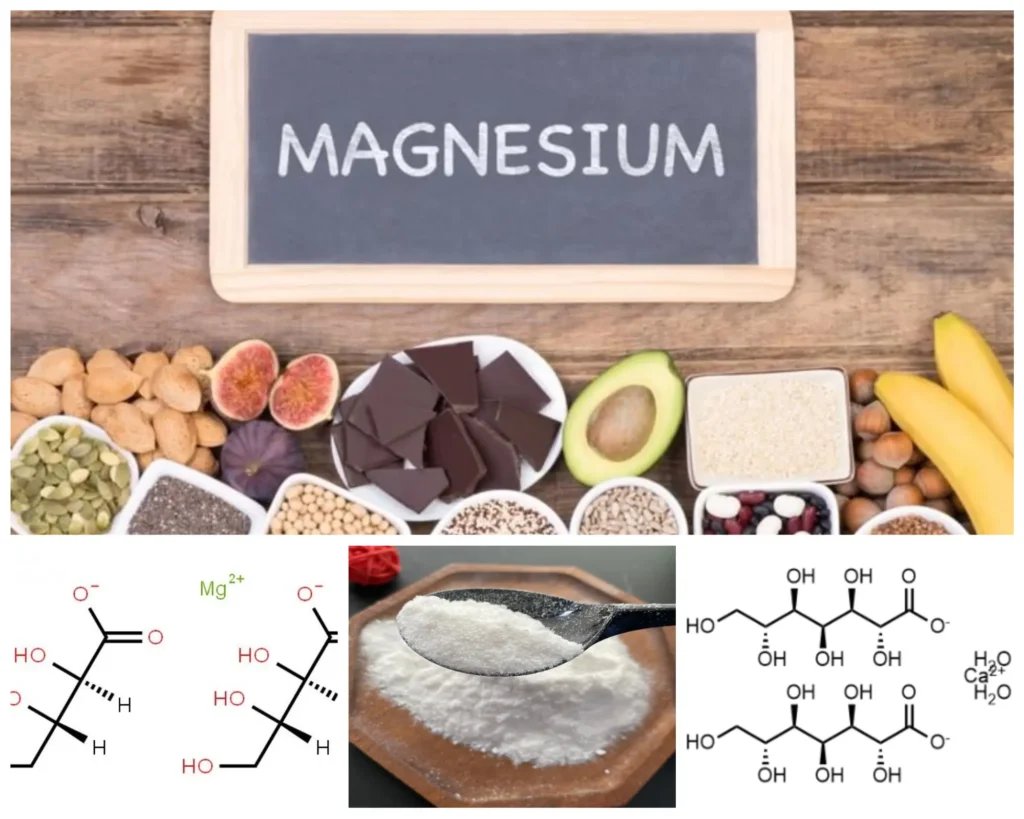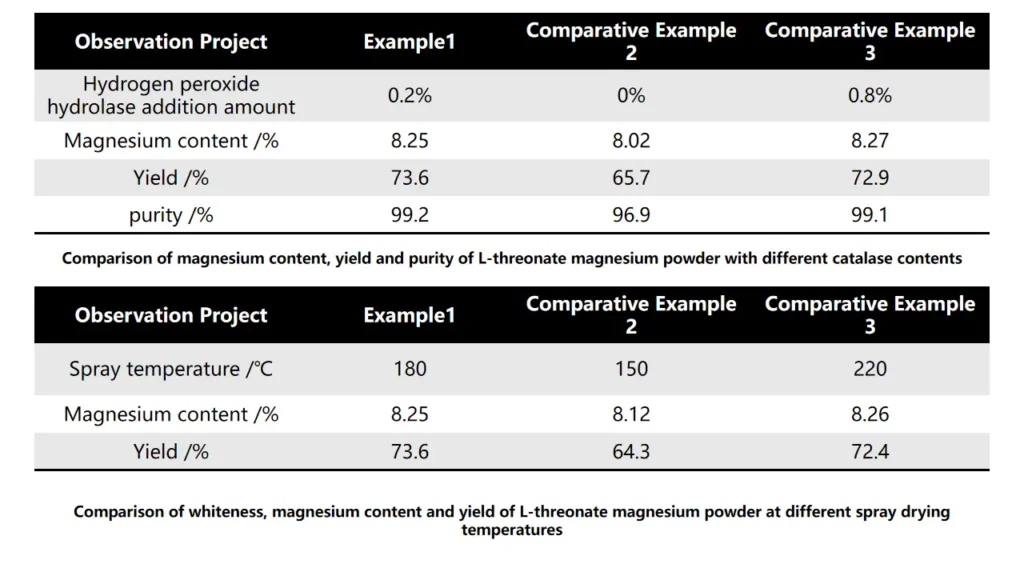Abstract
(1) Benefits of Magnesium L-Threonate
- Optimize memory
- Calming effect
- Improve sleep
(2) Supplement dosage forms
- Softgel: Magnesium Threonate Softgels in encapsulated liquid or semi-solid form are easy to swallow and improve absorption rate. They are used to relieve muscle spasms and improve sleep quality.
- Pills: Magnesium L-Threonate Pills with standardized doses are easy to carry and take. They are used to improve cognitive function and reduce anxiety.
- Tablets: Magnesium L-Threonate Tablets with multi-ingredient compound formulas are suitable for daily supplementation and are mostly used for bone health and overall health support.
- Gummy: Organics Magnesium Gummies have a good taste and are suitable for people who do not like to swallow pills. They are mainly used to improve immunity and support bone health.
- Powder: Can be added to beverages or food. It is suitable for a variety of application scenarios. It is mostly used for post-exercise recovery and daily health maintenance.
- Other Types: For example, Liquid Drops are used for rapid absorption and easy to adjust the dosage. For example, Oral Spray is easy to carry and use and takes effect quickly.
(3) Popular countries
This new magnesium supplement with L-Threonate Magnesium as an ingredient is widely popular in the following countries and regions:
- United States: Widely used in the dietary supplement market, mainly for cognitive function and sleep support.
- Canada: With the increasing demand for natural health products, L-Threonate Magnesium supplements are popular in the Canadian market.
- United Kingdom: The market that focuses on natural and organic products has an increasing demand for L-Threonate Magnesium supplements.
- Australia: As an important ingredient in health foods and supplements, L-Threonate Magnesium supplements are popular in Australia.
- Japan: The Japanese market has a high demand for functional foods and supplements, and L-Threonate Magnesium supplements are gradually becoming popular.
(4) Market prospects/advantages
- High demand: As people pay more attention to cognitive health and sleep quality, the demand for L-Threonate Magnesium supplements is growing rapidly around the world.
- Scientific support: More and more studies have shown that L-Threonate Magnesium has a significant effect on improving cognitive function, reducing anxiety and improving sleep quality, further driving market demand.
- High absorption rate: The unique structure of L-Threonate Magnesium gives it high bioavailability and absorption rate, which is superior to other magnesium supplements.
- Versatility: It can support cognitive function, bone health, cardiovascular health and sleep quality.
- High consumer acceptance: Soft capsules, gummies and powder forms are particularly popular and suitable for consumers of different ages.
- Natural ingredients: As natural ingredients, it caters to the current consumer preference for natural and organic products.
(5) Extraction technology/method
Chemical synthesis method: Using vitamin C, hydrogen peroxide and heavy magnesium oxide as raw materials, L-threonate magnesium powder is obtained through mixed reaction, enzyme catalysis and spray drying. This method has high reaction efficiency and high product purity, but the operation is complicated and requires precise control of temperature and reaction time.
(6) Specifications
- The dosage for formulating milk powder is 300mg/kg-1100mg/kg (in terms of magnesium)
- The dosage for beverage products is 30mg/kg-60mg/kg (in terms of magnesium).


Article Content
Magnesium L-threonate is a sugar acid present in the human body with the molecular formula Mg(C4H7O5)2·H2O. It is a patented compound developed by scientists at the Massachusetts Institute of Technology in 2010. Studies have shown that magnesium L-threonate has the effect of improving working memory, short-term and long-term memory and learning ability. Compared with other magnesium ion compounds, such as magnesium chloride, magnesium citrate and magnesium gluconate, magnesium L-threonate can significantly increase the level of magnesium ions in the brain and enhance cognitive ability. At the cellular level, magnesium ions participate in many enzymatic reactions as a cofactor and have a positive regulatory function on synaptic plasticity. It mainly affects the release of neurotransmitters before the synapse; it acts as a gating ion of the N-methyl-D-aspartate (NMDA) receptor complex after the synapse. Magnesium L-threonate also has the effect of providing concentration, alleviating hyperactivity, alleviating migraines, and preventing Alzheimer's disease. Magnesium L-threonate has a significant improvement effect on people with anxiety, sleep disorders and cognitive dysfunction.
1. Magnesium L-threonate Effects
A.Optimize Memory
Magnesium L-threonate helps improve cognitive function in older people. It is currently the only form of magnesium that can pass through the brain barrier and enter the nerve center. It is a supplement that can increase the concentration of magnesium in the brain. Magnesium threonate can significantly increase the activity and plasticity of synapses and promote hippocampal function. The role of magnesium L-threonate in neuroplasticity, learning and memory depends on its interaction with N-methyl-D-aspartate (NMDA) receptors. This receptor is located on neurons, where it receives signals from incoming neurotransmitters and then transmits the signal to the host neuron by opening channels to allow calcium to flow in. Magnesium L-threonate is a natural NMDA receptor antagonist, and this antagonism increases with increasing concentration. Magnesium L-threonate is relatively specific for NMDA receptor antagonism. Among NMDA receptor subunits, glutamate receptor 2A (NR2A) and glutamate receptor 2B (NR2B) are very sensitive to magnesium ion inhibition, while glutamate receptor 2C (NR2C) and glutamate receptor 2D (NR2D) are insensitive to magnesium ions. Another mechanism is that the lack of intracellular magnesium ions can enhance the activity of NR2B receptors.
B.Sedative effect
There is an interactive relationship between magnesium and mental health. Increasing magnesium intake may help relieve stress and anxiety. On the contrary, since stress may increase the amount of magnesium released into the urine by the kidneys, stress actually reduces the amount of magnesium in the body. Another study found that mice taking magnesium L-threonate were able to overcome fear faster and remain in an anxiety-free state longer than mice that did not take magnesium L-threonate for repair. This mechanism seems to be similar to the memory mechanism. Mice that took L-threonate magnesium were more likely to form new mental associations and retain new information. They were also able to adapt to the new safe environment faster than their counterparts who took L-threonate magnesium.
C.Improve sleep
Sleep is a spontaneous and reversible resting state that occurs periodically in higher vertebrates, which is characterized by a decrease in the body's responsiveness to external stimuli and a temporary interruption of consciousness. Sleep, as a necessary process for life, is an important part of recovery, integration and consolidation of memory, and is an indispensable component of health. Studies have shown that when barbiturates are used as hypnotic agents, barbiturates at higher concentrations exhibit a γ-aminobutyric acid-like effect and have a hypnotic effect. γ-aminobutyric acid type A receptors mediate rapid synaptic inhibition in the mammalian brain and control their activity at the network and cellular levels. Magnesium ions can enhance γ-aminobutyric acid-induced currents and affect the function of γ-aminobutyric acid type A receptors through positive allosteric regulation mechanisms. In addition, magnesium L-threonate has the function of alleviating certain pains and hyperalgesia, reducing anxiety, and may improve the body's comfort to a certain extent, thereby improving sleep.
2. Market prospects
It is widely popular in countries such as the United States, Canada, the United Kingdom, Australia and Japan. It has broad market prospects and has advantages such as high absorption rate, versatility and high consumer acceptance. In 2016, the National Health and Family Planning Commission of China issued Announcement No. 8, listing magnesium L-threonate as a new variety of food nutrient fortifiers for fortifying magnesium in food. The U.S. Food and Drug Administration approved it as one of the sources of magnesium compounds for use in food. GB 14880-2012 stipulates the main purpose of using magnesium L-threonate, usage requirements, fortified food categories and usage regulations of magnesium L-threonate. For example, the amount of magnesium L-threonate added to formula milk powder (except children's milk powder and pregnant women's milk powder) is 300mg/kg-1100mg/kg (in terms of magnesium), and the amount added to beverage products is 30mg/kg-60mg/kg (in terms of magnesium).
According to market research reports, the global magnesium-L-threonate market showed significant growth between 2018 and 2029.[1] The global magnesium supplement market is expected to reach approximately $19 billion in 2028, with an average annual growth rate of 8.2%[2]. This growth is driven by consumers' growing awareness of the health benefits of magnesium, especially the increased demand for cognitive function and sleep support. In terms of regional growth, North America, Europe, and Asia Pacific are the main consumer markets. Among them, the market growth in countries such as the United States, Canada, Germany, France, the United Kingdom, Japan, and China is particularly prominent.
3. Product Application
L-Threonate Magnesium is mainly used in the food additive and health care product markets, especially in supporting cognitive function and improving sleep quality. In the health care product market, L-Threonate Magnesium is suitable for a variety of supplement dosage forms, including soft capsules, tablets, tablets, gummies, powders, and other forms.
Magnesium is an essential mineral that is indispensable in enzyme reactions, and it plays a key role in memory formation and has a calming effect on the nervous system. The magnesium element must be combined with another substance (such as citrate or chloride) to form a stable magnesium salt structure. Choosing the composition of different compounds often affects the absorption and distribution of magnesium in the body. The difference between L-threonate and magnesium is not only that it can be fully absorbed by the body through the gastrointestinal system, but also that it has the unique ability to enter the brain from the blood. This significant feature makes it very different from traditional magnesium supplements, which have almost negligible effects on magnesium levels around brain neurons. For people who need to improve memory, regulate emotions and protect the brain, L-threonate can be used as a nutritional supplement to nourish the brain, enhance memory, relieve tension and protect brain nerves. And as a carrier of magnesium, threonate can increase the absorption rate of magnesium, while also improving the body's energy level and promoting the normal function of neurons.




4. Current status of production technology
Studies have shown that chemical synthesis is one of the main production methods of L-threonate magnesium. Existing methods use vitamin C, hydrogen peroxide, and heavy magnesium oxide as raw materials, and drop the concentrated solution into a micro-reflux ethanol solution for crystallization to obtain L-threonate magnesium. However, the addition of hydrogen peroxide in this method causes exothermic temperature rise. When the temperature is high, ascorbic acid will oxidize and turn yellow, and hydrogen peroxide will decompose, so the synthesis process needs to be cooled down; and hydrogen peroxide has low reaction efficiency and is easy to decompose, so excessive hydrogen peroxide is usually added, and the residual hydrogen peroxide will affect the next step of neutralization, and the excess hydrogen peroxide needs to be decomposed at high temperature later; because crystallization is difficult, it is necessary to add seed crystals after concentration, reflux ethanol to promote crystallization, and cool to 10-15°C; the process is complicated, the reaction speed is slow, and the yield is low.


5. Introduction to the scientific achievements
In view of the shortcomings of the prior art, the purpose of this method is to provide a method for preparing L-threonate magnesium powder, which includes mixing ascorbic acid solution and hydrogen peroxide solution, adding hydrogen peroxide hydrolase, adding magnesium carbonate suspension to the reaction system through the external circulation mode of the reaction system, filtering and spray drying after the reaction, and obtaining L-threonate magnesium powder; wherein magnesium carbonate is added every five minutes at 8-12% of its total amount. The above method adjusts the way of adding raw materials and adds enzyme catalysis to make the reaction more complete, the reaction efficiency faster and the product purity higher; by adopting spray drying instead of concentration and crystallization to recover the product, the problems of yellowing due to high-temperature concentration and sticky crystals are avoided, and the product yield is improved.
References:
[2]Magnesium L-Threonate Market, Global Outlook and Forecast 2023-2029.


